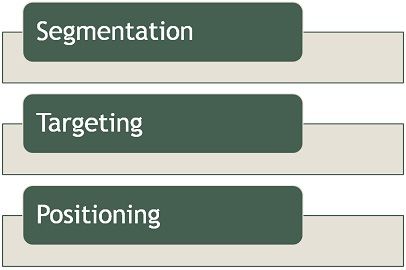 In segmentation, the entire market of consumers is broken down into a number of groups. These groups are segments that comprise consumers with similar characteristics. Of all these segments the company chooses one segment to focus on, to offer their products. This is the process of targeting.
In segmentation, the entire market of consumers is broken down into a number of groups. These groups are segments that comprise consumers with similar characteristics. Of all these segments the company chooses one segment to focus on, to offer their products. This is the process of targeting.
We all know that, when all the consumers of the product are taken together, it makes up the market for that product. But this is also true all the consumers are not the same. Therefore, the consumers may differ in:
- Needs
- Motives
- Characteristics
- Buying habits.
With this, we can conclude that the market for the product is heterogeneous in nature. So, the marketers can divide the entire market into submarkets. These sub-markets are homogeneous.
In this write-up, we will discuss the difference between segmentation and targeting.
Content: Segmentation Vs Targeting
Comparison Chart
| Basis for Comparison | Segmentation | Targeting |
|---|---|---|
| Meaning | Segmentation is the process of classifying the market into several approachable groups. | Targeting is the process of concentrating on a particular segment of the market to offer products, of all the segments of the market. |
| Concerned with | Dividing up the market, by grouping the customers with similar needs. | Choosing the right segment considering different factors. |
| Bases | Need, Interest, Marital Status, Sex, Buying Behavior, etc. | Attractiveness of the segment |
| Stage of Target marketing | First | Second |
Definition of Segmentation
Segmentation implies splitting the heterogeneous market into relatively distinct homogeneous sub-market. To divide the market, specific criteria form the base.
These groups possess consumers, having common characteristics. The characteristics include age, income, sex, personality traits, or behavior. It aims at determining the consumer groups whose needs can be fulfilled with one common product. Above all, it ensures the concentration of the efforts of the firm in an effective and economical manner.
This helps in tapping the market in a better manner. Besides, it also helps in optimizing products and advertising them to consumer groups.
What is Market Segment?
Market Segment is that part of the entire market, wherein the consumers have one or more things in common. And due to this reason, their product needs are the same.
It is a strategic marketing tool. This is used to determine the market and also to allocate resources.
Assumptions of Market Segmentation
- All the buyers are not the same.
- Identification of consumers with similar characteristics. These can be background, need, values, behaviors, and so forth.
- There will be small sub-groups and often homogeneous in nature, as compared to the market.
- It is easier for the marketer to satisfy a small group with similar customers than a large group with diverse customers.
Requirements of Effective Segmentation
- Measurability: The segments have to be measurable. In other words, the quantification of the segment should be possible so that the size can be estimated.
- Accessibility: Segmentation should be done in a manner that the marketer may get through and serve the segments.
- Viability: Segments should be cost-effective as well as profitable to the marketer.
- Intensity: Attractiveness of segment is also ascertained by its intensity with regard to inter-firm rivalry. A higher intensity indicates more competition between firms. Therefore, it makes the segment unattractive for the marketer.
Video: Market Segmentation
Also Read: Difference Between Traditional Marketing and Digital Marketing
Definition of Targeting
After the creation of different segments, managers decide which segment is best to target. For the purpose of targeting the company takes into account its ultimate objectives. In practice, managers go for that segment that is highly profitable. But, the firm can also aim for that segment that is less likely to attract competitors.
In other words, targeting is the process of choosing one segment, of all the segments, to aim for. There are three strategic options are available to the marketers which are:
- Concentrated Marketing: In this, the company focuses on a single segment at a time. Another term used for this is niche marketing. In this, the marketer attempts to become the blue-chip within that segment.
- Differentiated Marketing: In this strategy, the marketer concentrates on more than one segment at a time. Also, the company offers a differentiated marketing mix for each segment. The alternative name of this is multi-segmented marketing.
- Undifferentiated Marketing: In this, the marketer uses a ‘scattergun’ approach. Therefore, the marketers offer one basic product that would serve the needs of people belonging to different age groups and lifestyles.
The marketer’s decision about the adoption of strategy depends on these factors:
- Company’s Resources
- Product features and benefits
- Characteristics of the segment
Targeting Strategies
Standardization:
Here, the firm offers a similar product to different segments. For this, the same communication, distribution, and pricing strategy are used.
Differentiation:
In this, the company differentiates its products to match the needs and expectations of different segments of the market.
Focus:
It is a hybrid strategy. That is to say, it combines both standardization and differentiation strategies. Also, the ‘core strategy’ remains unchanged, but differentiation is implemented to fulfill the requirements of specific consumers.
Also Read: Difference Between Product Marketing and Service Marketing
Key Differences Between Segmentation and Targeting
The points listed below explain the difference between segmentation and targeting:
- Segmentation is the practice of classifying the broad customer base into several sub-groups. It may comprise both existing customers and prospective ones. In contrast, targeting is the practice of evaluating the attractiveness of different segments and choosing a segment to enter.
- Segmentation is concerned with breaking down the heterogeneous market into sub-units. These sub-units have consumers with homogeneous needs. However, in targeting, the firm targets a particular segment considering various factors.
- To divide the target audience into segments the marketers create groups. These groups rest on shared characteristics like common needs, interests, lifestyles, or profiles. As against, the attractiveness of the segment is the basis of targeting.
- Segmentation is the first stage of target marketing. Whereas targeting is the second stage.
Bases for Market Segmentation
There are two approaches for segmentation of the market:
People-Oriented Approach
Here the segmentation relies on consumer characteristics. The bases can be: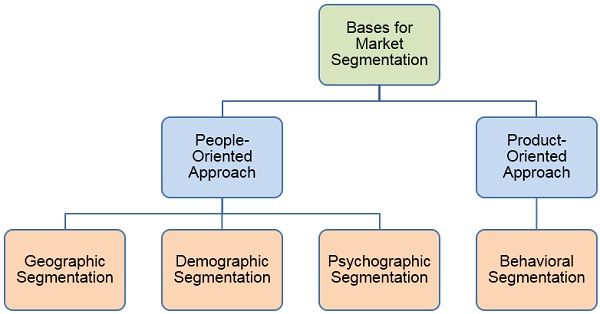
- Geographic Segmentation: In this, the segmentation of the consumer is location-wise. The division is as per Country, State, Region (Urban or rural), Cities (Tier-I, Tier-II, and Tier-III). This is because the climate, needs, preferences, and wants of people living in different places vary. With that in mind, the company divides its market into these segments geographically:
- Local Market
- Urban Market
- Rural Market
- Regional Market
- Global Market
- Demographic Segmentation: Demography is concerned with the population of the country. Here, many factors influence the needs, preferences, and usage rate of the consumers. The demographic classification of the consumer can be done on the basis of:
- Age
- Sex
- Family Size
- Family Life Cycle
- Income
- Education
- Castes and Social Classes
- Occupation
- Nationality
- Religion
- Psychographic Segmentation: Psychographic mean intrinsic virtues of an individual. These characteristics form the basis of market segmentation. It may cover the following bases:
- Social Class
- Lifestyle
- Personality
- Buying Motives
Product-Oriented Approach
Here, market segmentation depends on product characteristics. Also known as consumer response segmentation or behavioral segmentation. The bases are:
- Occasions: There are certain products that consumers buy on specific occasions. Even, the company advertises its products by associating its use with that occasion. These occasions increase demand for that product. The products can be clothing, jewelry, firecrackers, greeting cards, and so forth
- Benefits: Benefits derived by consumers from products are also a basis of segmentation. It can be quality, services, economy, ease of use, safety, durability, warranty, and so forth.
- User Status: User status also acts as a basis for dividing the market. They are:
- Non-users
- Ex-users
- Prospective users
- First-time buyers
- Occasional users
- Regular users.
Here, the company aims at converting all the users into regular users. And to do so companies make use of different marketing techniques.
- Usage Rate: The usage rate of different consumers vary. They include:
- Light users: Users are more in number but they buy a very little quantity.
- Medium users: Users are more in number and consume more quantity as compared to the light users.
- Heavy users: USers are few in number but consume a very high quantity of that product.
- Loyalty Pattern: All the consumers are not the same in terms of loyalty. This means, there is a varying degree of loyalty of consumers towards the brand. It is reflected through their buying patterns. They are:
- Hard-core loyal
- Soft loyal
- Shifting loyal
- Brand switchers.
The company’s marketing efforts aim for increasing the number of hard-core consumers.
- Buyer Readiness Stage: The stages of readiness of consumers are different. They are:
- Unaware
- Aware
- Informed
- Interested
- Desirous
- Intended
- Attitude towards products: The attitude of the buyers may differ greatly. This acts as a basis for segmenting the market. The buyers include:
- Enthusiastic
- Positive
- Indifferent
- Negative
- Hostile.
Conclusion
Above all, market segmentation deals with fragmenting consumers based on their needs. But, targeting is all about selecting a segment of all the segments, to aim for.
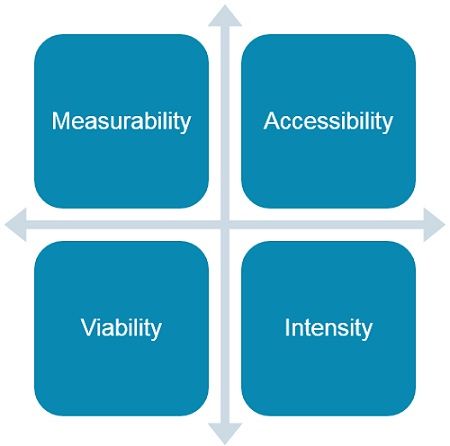
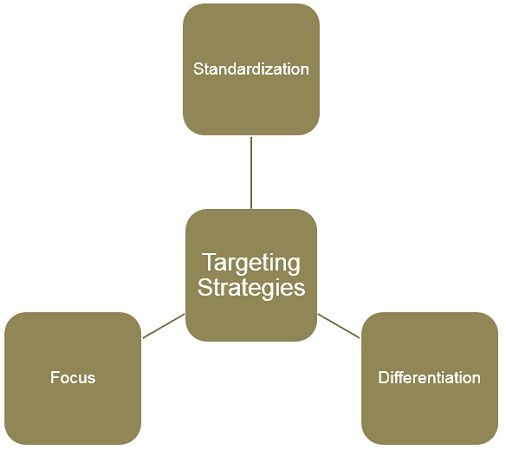





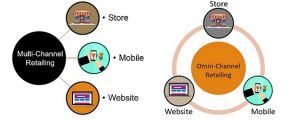
Leave a Reply